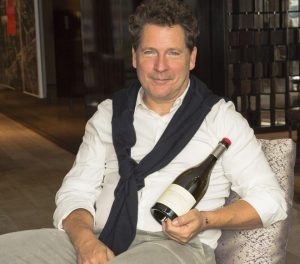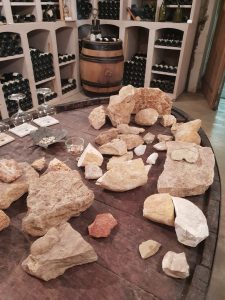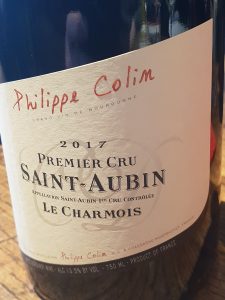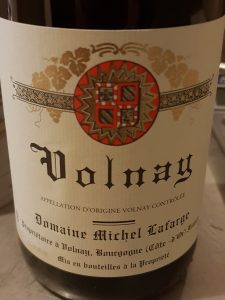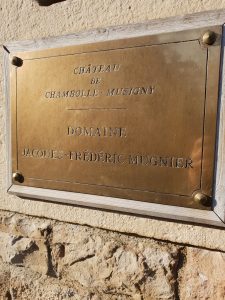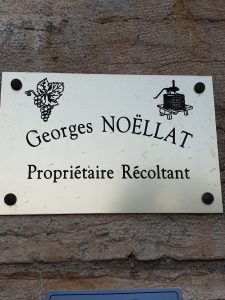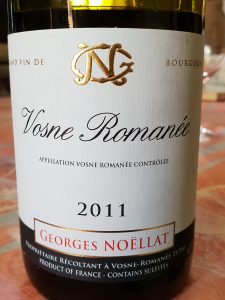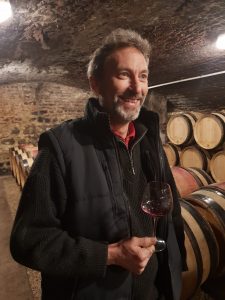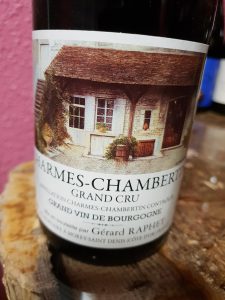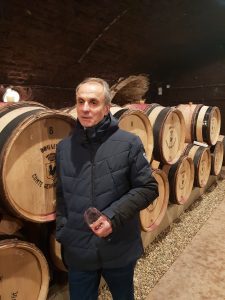Living, as I do, in the world’s foremost winegrowing region, you may wonder what motivates me to regularly visit another region, indeed, one that has the temerity to consider itself a rival… The simple fact is that viewing Bordeaux and Burgundy as mutually exclusive is exceedingly silly. For complicated reasons (essentially a superiority-cum-inferiority complex), I daresay the Burgundians are more chauvinistic than the Bordelais, who freely acknowledge that the white wines of the Côte d’Or are better than those of the Gironde, and admit to having only a limited acquaintance with red Burgundy. That is due in no small part to the fact that it is not easy to buy fine Burgundy. French supermarkets – i.e. where most people buy wine – often stock classified growth Bordeaux, but rarely premier and grand cru Burgundy.
My personal opinion (what are blogs for, after all?) is that the type of wine one chooses depends to a certain extent on the food that accompanies it. For instance, I would prefer a good Médoc with a grilled steak, but a Burgundy with meat in a sauce, or a stew.
The Bordelais were roundly and bitterly criticized when the prices of their great growths rose dramatically in the mid-2000s. A “fox and the grapes” situation set in and many consumers turned away from Bordeaux, finding reasons other than just expense and, somewhat unfairly, equating the name “Bordeaux” with just the tiny tip of the pyramid (the famous grands crus classés).
In the past 5 years, Burgundy has come more into the limelight on the global market, including China, but at a time when the region had several small or even painfully small vintages in a row. This inexorably led to price rises as staggering as those in Bordeaux the previous decade. Bordeaux now figures nowhere near as prominently as Burgundy on the list of the world’s most expensive wines.
The difference is, of course, that even the finest châteaux in Bordeaux can be quite large. Compare Lafite Rothschild’s 112 hectares with La Romanée’s 0.85 hectares… And the latter is not only a grand cru, but an entire appellation unto itself.
In short, we are talking about two very different realities.
In any event, I have made an annual pilgrimage to Burgundy for the past decade and love the region. This year, I was able to spend two full weeks and visited 27domaines. I am deeply indebted to my friend Ian Westcott, an importer in Melbourne, for making the appointments.
My report is listed in alphabetical order. I have abridged tasting notes and, in most instances, simply omitted them and listed the wines in order to avoid overkill. In fact, if I had included my impressions of each and every wine, this post would have taken on the size of a small book. If anyone is interested in a particular wine, please contact me by e-mail.
I will share a few general observations at the end, as well as my take on the restaurants I went to.
- Cyrprien Arlaud
Domaine Arlaud (Morey-Saint-Denis) – Cyprien Arlaud epitomizes the new face of Burgundy. Circumspect and forward-looking, he also practices biodynamic viticulture, certified as such since 2014. His modern winery in Morey is impeccably kept and Cyprien is at ease explaining the situation at his 8-hectare domaine and in Burgundy as a whole. He described 2017 as a “cool vintage” with freshness and true Burgundian character. We tasted 12 wines, all red and all 2017s. These included: Chambolle-Musigny Village, Morey-Saint-Denis Village, Gevrey-Chambertin Village, and Vosne-Romanée Village (and I might add that all of these were fine examples of their appellation, a definite cut above average), followed by Vosne Aux Réas, Nuits Premier Cru Les Porrets Saint Georges, Morey Premier Cru Les Blanchards, Morey Premier Cru Les Ruchots, Gevrey Premier Cru Les Combettes, Charmes Chambertin, Clos de la Roche, and Clos Saint Denis. The house style is pure, well-focused wines of high quality. I was particularly impressed with the Clos de la Roche.
Domaine des Beaumont (Morey-Saint-Denis) – We tasted seven red wines from this 5-hectare domaine chez Pierre Labet, but did not visit. All were 2017s except the 2016 Les Cherbaudes. In order, these were : Chambolle-Musigny Les Chardannes (with a nose marked by oak and strawberry and somewhat hollow on the palate), Morey-Saint-Denis village (deep black fruit bouquet, full body, and nice tart finish), Morey-Saint-Denis Premier Cru Les Millandes (spirity nose and not quite balanced on the palate), Gevrey Chambertin village (some spice and possible brett on the nose, but showing better on the palate), Gevrey Chambertin Premier Cru Les Combettes (sweet fruit aromatics and then quite poised and velvety on the palate, very attractive and in another dimension from the others), Gevrey Chambertin Premier Cru Les Cherbaudes (not noted, a winemaking problem there), and Charmes Chambertin (classy nose and sinewy, silky, big, and powerful on the palate with more than a little oak showing – very good).
- Olivier Bernstein
Olivier Bernstein (Beaune): Olivier is quite a character and, much like me, he is voluble and has strong opinions on just about everything… After several years making wine in the Roussillon, he decided to set up shop in Beaune. His newly-equipped cellars are in a large historic building in the town of Beaune. Although Olivier’s business is relatively recent (his first vintage was 2007), his wines have achieved critical acclaim and are imported into the UK by Berry Brothers & Rudd and the US by Wilson Daniels. Olivier buys most of his grapes (he also owns plots in Gevrey Premier Cru Les Champeaux and Mazis-Chambertin), but insists that he should be considered a domaine because he looks after the vines from A to Z. In other words, he rents land from the vineyard owners, but he is the grower, completely in the driver’s seat. We tasted 11 wines, all red and all from the 2018 vintage: Gevrey-Chambertin Village, Chambolle-Musigny Premier Cru Les Lavrottes, Gevrey-Chambertin Premier Cru Les Champeaux, Gevrey-Chambertin Premier Cru Les Cazetiers, Charmes-Chambertin, Clos Vougeot, Clos de la Roche, Bonnes Mares, Mazis-Chambertin, Clos de Bèze, and Chambertin.
The wines were exuberant, fruity, and fairly oaky. I would venture to stay they are in a “modern” style, and I’ll be interested to check back with them after some bottle age.
Oliver was kind enough to invite us to lunch at the Bistro de l’Hôtel de Beaune, where the high standard of traditional French cuisine is perpetuated.
- Grégory Patriat
Jean-Claude Boisset (Nuits-Saint-Georges) – Boisset is the largest négociant in Burgundy, and the 4th largest in France. It is such a big organization that it has several completely independent subsidiaries producing wines ranging from large-volume basic ones to some of the best in Burgundy (Domaine de la Vougeraie). The Jean-Claude Boisset négociant firm we visited in Nuits-Saint-Georges is somewhat between the two, and has one of the most beautiful winemaking facilities I have ever seen. It is housed in a former Ursuline convent daringly and successfully renovated by Frédéric Didier, the architect in charge of architecture at the Château de Versailles. No expense was spared, and the result is impressive. In fact, the day we were there they were preparing to welcome the Prime Minister of France, Edouard Philippe, for a meal.
Back to wine, we tasted six altogether. The four whites were 2017 Bourgogne Chardonnay, a 2015 Aligoté, 2016 Château London (!) Mâcon Igé, and 2016 Marsannay. The reds were 2017 Bourgogne Pinot Noir and 2013 Beaune Premier Cru Les Grèves. The wines (all from purchased grapes) were good, well-focused, and in the affordable mid-range vein.
Above and beyond the pleasure of discovering them, we very much enjoyed talking with Grégory Patriat, the ambitious, energetic, and, somewhat iconoclastic winemaker (“corks are toxic”) since 2002, who would be very much at home in the New World.
The name Boisset is frequently associated with a megafirm that churns out cheap and cheerful products. However, a visit and tasting at J.C. Boisset in Nuits will undoubtedly dispel that idea.
- Patrick & Kate Essa
Domaine Buisson Charles (Meursault) – It is always a great pleasure to visit Patrick and Kate Essa, for whom wine is not just a business, but a passion and a lifestyle. Patrick teaches physical education, but still finds time to work in the vineyard and cellar, as well as make frequent learned contributions about the wines of Burgundy on the internet. He is the best blind taster I have ever encountered and has a wonderful way of describing wines. A tasting with Patrick is by definition time-consuming and fascinating. Buisson-Charles have 6.5 hectares of vines, but also buy grapes.
We started the tasting with the 2018s.
There were 8 whites: Aligoté “Sous le Chemin”, Bourgogne Côte d’Or “Hautes Coutures”, Meursault Pellans, Meursault Vieilles Vignes, Meursault Premier Cru Les Charmes, Meursault Premier Cru Les Bouches Chères, and Meursault Premier Cru La Goutte d’Or.
Patrick is justifiably well-known for his whites. As good as his premiers crus were, I have a penchant for his Meursault Vieilles Vignes, one that was confirmed when I tasted the 2018.
These were followed by five 2018 reds: Bourgogne Rouge (traditional), Bourgogne rouge (without sulfur), Corton Bressandes, Volnay Premier Cru Les Santenots, and Volnay Champans. The Volnays exceeded my expectations and the Corton was both good and powerful.
We then went through a series of 2017s:
White: Chablis, Bourgogne Blanc, Chablis Premier Cru Les Lys, Meursault Vieilles Vignes, Chassagne-Montrachet Premier Cru La Romanée, Puligny-Montrachet Premier Cru les Folatières, Meursault Premier Cru Les Charmes, Meursault Premier Cru La Goutte d’Or, and Corton Charlemagne. I thought La Romanée was particularly good and that La Goutte d’Or and Corton Charlemagne did honor to their prestigious terroirs.
We finished with two 2017 reds: Volnay Premier Cru Les Santenots, and Volnay Champans, which I purchased for my cellar, along with the 2017 Meursault Vieilles Vignes.
Domaine Philippe Charlopin (Brochon) – We tasted one white and five reds from this 25-hectare domaine chez Pierre Labet, but did not visit. The 2015 Bourgogne Blanc was a very good example from this entry level appellation, a fun wine that is ready to drink. The red wines, unfortunately, were a mixed bag. The 2015 Pernand-Vergelesses village was old-fashioned and grippy, whereas the 2015 Marsannay village was brilliant: expressive, seductive, easy-drinking, and moreish. From this point on, the wines seemed unfortunately to go downhill. The 2015 Morey-Saint-Denis village had a peppery, reduced nose and was rather unpleasant on the palate. The Gevrey-Chambertin Terres Blanches had off-putting gunpowder aromatics, and even the 2015 Charmes-Chambertin Grand Cru was not up to scratch. I’m no enologist, but these reds clearly had some sort of winemaking flaw.
Domaine Robert Chevillon (Nuits-Saint-Georges) – We were welcomed by Bertrand Chevillon, a friendly, no-nonsense, and gifted winemaker. Many Burgundy lovers tend to snub the wines of Nuits, but Domaine Chevillon produces some very classy wines and sells them at prices that do not make one stumble and faint. From the delicious 2017 Nuits-Saint-Georges village, we went on to taste the whole range of NSG premiers crus from the same vintage: Les Chaignots, Les Bousselots, Les Roncières, Les Perrières, Les Pruliers, Les Cailles, Les Vaucrains, and Les Saint Georges. It is always a fascinating exercise to see the nuances between these. I preferred Les Bousselots, Les Perrières, Les Cailles, and Les Saint Georges. As for Les Saint Georges; I asked the ritual question: how is the candidacy for grand cru status coming along? The answer is that things are moving at a snail’s pace and some Byzantine local politics are involved… Be this as it may, Chevillon does good work and it is always a pleasure to visit his cellar.
- Bruno Clair (middle), his son (left) and Philippe Brun (right)
Domaine Bruno Clair (Marsannay-la-Côte) – It is hard for me to be objective about this domaine because I have known winemaker Philippe Brun since my California days several decades ago. Bruno Clair has 24 hectares of vines (big for Burgundy) including in some of the greatest climats. The range is quite large. We tasted 20 wines, all from 2017. The reds started off with three Marsannays: Les Grosses Têtes, Les Longeroies (which is aspiring to premier cru classification), and a blended village wine. These were all light and elegant. We went on to taste Vosne-Romanée Les Champs Perdrix, Chambolle-Musigny Les Véroilles, and Morey-Saint-Denis En La Rue de Vergey , followed by four Gevrey-Chambertin premier crus – Clos de Fontenay, La Petite Chapelle, Les Cazetiers, and Clos Saint Jacques. I must say that this set of Gevrey’s was wonderful, especially the Clos Saint Jacques that Bruno Clair is famous for. The end of the series was a firework display of Clos de Bèze and Bonnes Mares.
There did seem to be a house style here: fruity, supple, wines enjoyable young or with age.
The reds were followed by 6 whites: Bourgogne Blanc, Marsannay Blanc, Marsannay Sources de Roches, Marsannay Langeroies, Pernand-Vergelesses, Morey-Saint-Denis En La Rue de Vergey, and Corton Charlemagne. I found the white Marsannays very good and bought some for my cellar.
Bruno, Philippe, and the three of us went on to have lunch at the Rôtisserie de Gevrey Chambertin and there was no lack of things to discuss: trends in Burgundy, the Chinese market, the gilets jaunes, etc., etc.
- Bruno Clavelier
Domaine Bruno Clavelier – Bruno Clavelier is a real salt of the earth kind of guy, unprepossessing and constantly smiling. Terroir is like a religion to him and every visitor is entitled to a detailed explanation of the geology of his various vineyard plots, which are farmed biodynamically. The table in his tasting room is strewn with rocks to illustrate his points. We tasted 13 of Bruno’s wines. The two whites, an Aligoté and a Bourgogne Blanc were good, but not remarkable. The reds were another story. These included Bourguigne Passetoutgrains, Bourgogne Rouge, three Vosne-Romanée village wines (Les Hauts de Beaux Monts, La Combe Brûlée, and Les Hautes Mazières), as well as a long series of premiers crus: Gevrey-Chambertin Les Corbeaux, Vosne-Romanée Aux Brûlées and Les Beaux Monts, Chambolle-Musigny Les Noirots and Combe d’Orveaux, and Nuits-Saint-Georges Aux Cras. Bruno was proud to have recently acquired a plot of grand cru vineyard, Corton-Rognet, which we tasted for the first time.
It would probably be long and boring to reproduce all my tasting notes. Let it suffice to say that the style here is pure and mineral. The Combe d’Orveaux is a special treat, and Bruno was kind enough to open a 99 of this for us to drink, not just taste!
Domaine Philippe Colin (Chassagne-Montrachet) – We tasted two 2017 white wines from this 8.5-hectare domaine chez Pierre Labet, but did not visit. The Saint-Aubin Premier Cru les Charmois was rather disappointing. The Chassagne Montrachet village was, of course, a step up, but I also found it weak and not particularly impressive.
- Michel Di Gioia
Domaine Digioia-Royer (Chambolle-Musigny) – We were welcomed at this small domaine (under 5 hectares) by the friendly Michel Di Gioia (whose name means “de la joie”, or “joy” in Italian!) and tasted through his entire range. From the sympatico 2017 Bourgogne Blanc, to a fruity, light Bourgogne Rosé (I bought a case), to 8 red wines. I will list these (all 2017) and then give a summary: Bourgogne Rouge, Hautes-Côtes-de-Nuits, Savigny-lès-Beaune Dessus-Les-Vermots, Nuits-Saint-Georges Les Charmois, Chambolle-Musigny village, Chambolle-Musigny village vieilles vignes, Chambolle-Musigny Premier Cru Les Gruenchers, and Chambolle-Musigny Premier Cru Les Groseilles. The house style is middle-of-the-road in terms of quality with an honest and not unappealing rustic aspect. As to be expected, the premiers crus showed more class. The notion of value for money must be introduced here because these good, honest wines cost significantly less than most of his neighbors’.
- Cyril Ponelle
Joseph Drouhin (Beaune) – With 80 hectares of vines (including 40 in Chablis), Drouhin is not only a major Burgundy négociant, but also one of the largest vineyard owners in the entire region. Viticulture is entirely organic. They also have a domaine in Oregon. The Drouhin cellars in Beaune are very picturesque and quite mammoth. We tasted 8 wines by candlelight in the company of the affable Cyril Ponelle.
There were 3 whites: a 2015 Chablis Premier Cru Mont de Milieu, 2016 Pouilly-Vinzelles, and 2014 Chassagne-Montrachet Embazées.
The reds were, in order: 2014 Fleurie, 2014 Chambolle-Musigny Premier Cru (blend of 6 different plots), 2014 Beaune Premier Cru Les Grèves, and 2012 Corton (a blend of Bressandes and Perrières).
Seeing as how we were very interested and generally well-behaved, Cyril also opened a mystery wine, which turned out to be 1983 Musigny, which was consumed rather than spat out J. This was just as well, because the wine was delicious, with a monumentally long aftertaste.
- Christine Drouhin
Domaine Drouhin Laroze (Gevery-Chambertin) –
I have visited the domaine a number of times and always appreciate Christine Drouhin’s warm welcome. She speaks good English and has a very outgoing personality. Her husband, Philippe, has largely handed over winemaking to their two children, Nicolas and Caroline. I used to think of wines from this estate as more stolid and affordable than exciting, but they have recently taken on another dimension in my opinion, perhaps as a result of the new generation. I think this is definitely a domaine to watch. 46% of their vineyard holdings (11.5 hectares) are grands crus. We tasted through the entire range of wines (2017 vintage): Gevrey-Chambertin village, Gevrey-Chambertin En Champs, Gevrey Premier Cru Au Closeau, Gevery Premier Cru Lavaux Saint Jacques, Chapelle-Chambertin, Latricières-Chambertin, Bonnes Mares, Clos de Vougeot, Clos de Bèze, and Musigny.
As good as the Musigny was, the Bonne Mares and, especially, the Clos de Vougeot were in the same league.
- Pierre Duroché
Domaine Duroché (Gevrey-Chambertin): We were welcomed at the cellars of this 8.5 hectare domaine by Pierre Duroché, who has represented the fifth generation of his family to make wine here since 2005. Demand for wines from this producer is great, and the better wines are in short supply. We tasted several of his 2018s before repairing to his tasting room where he served us 2015 and 2008 Gevrey-Chambertin Aux Etelois, followed by a 2012 Latricières-Chambertin. The level of winemaking is quite high and I hope to be able to buy some Duroché wines for my cellar next time around (this was not possible in 2019).
- Paul Gros
Domaine Anne Gros (Vosne-Romanée) – Seeing as Anne was vacationing in the Caribbean, her son Paul looked after us. He was back in Burgundy after a long stint at his parents’ estate in the Minervois. We tasted 10 wines from the domaine’s six hectares of vines – two 2018 whites, Bourgogne Blanc and Hautes-Côtes-de-Nuits, followed by eight 2018 reds: Bourgogne Rouge, Hautes-Côtes-de-Nuits, Chambolle-Musigny La Combe d’Orveau, Vosne-Romanée Les Barreaux, Echézeaux, Clos Vougeot (from the Grand Maupertuis part), and Richebourg. As for the Richebourg, we tried this from two different barrels. The first was from the lieu-dit “Les Verroilles”, which showed tremendous class, with an ethereal violet bouquet and a velvety texture, and the second was the same wine from a new barrel which, as good as it was, perfectly illustrated why 100% new oak would unquestionably have overshadowed this great wine.
I have visited Anne Gros several times, and have usually found that promoting her Minervois wines, there in Burgundy, was not such a good idea. But I have mellowed on that and enjoyed the 8 Minervois I tasted with Paul, who knows them intimately. He too felt that La Ciaude, from a vineyard with pebbly soil, was the best of the lot, and I bought a few bottles for the cellar.
- Charles Van Canneyt
Domaine Hudelot-Noëllat (Vougeot) – Young Charles Van Canneyt is a competent winemaker as well as a very friendly guy. His wines have a loyal following, especially in the UK, and it is not hard to see why. We started off with the Domaine’s first ever white wine, 2017 Meursault Clos des Ecoles (a leaseholding recently taken over from Coche-Dury), which left a very good impression. The 2017 reds had mostly just been bottled, so we did not taste the usual range. Instead, we focused on 2017 Vosne-Romanée Village and Nuits-Saint-Georges Premier Cru Les Murgers. Having a go at Vosne-Romanée Premier Crus Les Malconsorts and Les Suchots, as well as Richebourg will have to wait for another time
- Valentin Jobard
Domaine Jobard-Morey (Meursault) – I must say I have a soft spot for this 6-hectare domaine. Young Valentin Jobard is very go-ahead young winemaker who had just returned from a trip to Asia. We tasted four of his white wines and one red (all 2017s). The Bourgogne Blanc was all you would want from an entry level appellation, and I bought a few bottles for the cellar. Although the Meursault Village appeared a little weak, the Les Narvaux lieu dit was better. Meursault Premier Cru Les Poruzots showed more character, length, and depth, as well as good potential. The Meursault Premier Cru Les Charmes was in a different, more rich and traditional style. Valentin also makes a red Coteaux Bourguignons from old vines, a very friendly, fruity wine. This time around we did not taste his rare Meursault rouge. The prices are definitely in the moderate category.
- Etienne Julien
Domaine Gérard Julien (Comblanchien): Although on the main Route Nationale passing through the Côte d’Or, this domaine has a low profile. For instance, it is not listed in Jasper Morris’s excellent “Inside Burgundy”. Truth to tell, the first impression of the place is rather ramshackle. But, as we all know, appearances can be deceiving… We were welcomed by the affable Etienne Julien, fifth-generation winemaker since 2010. We tasted through 8 of his wines, all from the 2016 vintage, except for the first one, a 2018 Aligoté. The reds included Aloxe-Corton Village, Côtes de Nuits Village, Nuits-Saint-Georges Village, Nuits-Saint-Georges Aux Saints Juliens, and Echézeaux. I was pleasantly surprised by the quality of the wines, especially in light of their attractive prices. This is a place for people who love good, authentic, if not unspeakably elegant Burgundy at an affordable price point, and are not interested in the darlings everyone is scurrying after. I bought a case of the Aux Saints Juliens for my cellar.
- François (left) and Edouard (right) Labet
Domaine Pierre Labet (Vougeot) – This 9-hectare domaine has cellars at Château de La Tour, which is actually located within the Clos de Vougeot (although we did not sample the family’s grand cru wine). We were welcomed by enthusiastic young Edouard Labet and his father, François. The domaine has been organic since 2015 and will soon receive certification to that effect. They have joined forces with about 25 other producers to sell their wines in Asia, which explains why we tasted wines from three other domains while we were there. These are listed elsewhere. The Labet family also makes wine in Corsica, which we did not have time to taste.
We started with the red wines (all 2017): a pretty Bourgogne rouge, Beaune Clos de Dessus des Marconnets (a feminine, upfront wine with a serious aftertaste that will show well young), Beaune Premier Cru Aux Coucherais that was a bit on the light side, and a Gevrey-Chambertin village which was quite big, with some candied fruit and a tart finish.
The whites, also all from the 2017 vintage, included a Bourgogne blanc (better in its category than the red), the white Beaune Clos de Dessus des Marconnets with an immediately appealing bouquet (although slightly less good on the palate), and Meursault Les Tillets with a very seductive nose and a fine silky texture, if not very concentrated.
- Frédéric Lafarge
Domaine Michel Lafarge (Volnay) – Burgundy lovers revere this estate not only because Frédéric Lafarge and his father, Michel, are adorable, but because the cobwebbed cellars exude tradition, as do the wines.
We tasted a range of 2017s. The whites included an Aligoté Raisin Doré, Meursault Village, Meursault Village Vendanges Sélectionnées, and Beaune Premier Cru Les Aigrots blanc.
Then came no fewer than fifteen 2017 reds :
These included 11 Burgundies: Bourgogne Passetoutgrains (more about that at the end of the report), Bourgogne Pinot Noir, Volnay Village, Volnay Vendanges Sélectionnées, Beaune Premier Cru Les Aigrots, Beaune Premier Cru Les Grèves, Volnay Premier Cru Les Pitures, Volnay Premier Cru Les Mitans, Volnay Premier Cru Les Caillerets, Volnay Premier Cru Clos des Chênes, and Volnay Premier Cru Clos du Château des Ducs.
The four remaining wines (also 2017s), were from the 4-hectare Domaine Lafarge-Vial in the Beaujolais (belonging to Frédéric Lafarge and Chantal Lafarge-Vial): Chiroubles, Fleurie, Fleurie Clos Vernay, and Côte de Brouilly.
As stated at the beginning of this report, reproducing tasting notes for 19 wines would be too overwhelming, so let me summarize by saying that the whites were good, if unremarkable, the red Burgundies were elegant and more forward/easy-going than I have found in previous years, and that the Beaujolais were juicy and typical of their appellations, except perhaps for the Côte de Brouilly which seemed to have a “gout de terroir”.
- Nicole Lamarche
Domaine Lamarche (Vosne-Romanée) – It is always a pleasure to see Nicole Lamarche. When I first met her, she had a ring through her nose, had recently become the single mother of twins, and the thought of receiving foreign wine lovers was intimidating and not exactly her idea of fun. She has acquired tons of experience and self-assurance since then, and now runs the estate as well as any man. She was just back from a trip to Hong Kong. We sat down in a small, cosy tasting room and sampled 8 wines from the domaine’s 8 hectares of vines: Bourgogne Rouge, Vosne-Romanée Village, Vosne-Romanée Premier Cru Les Chaumes, Vosne-Romanée Premier Cru Les Suchots, Vosne-Romanée Premier Cru Les Malconsorts, Echézeaux, Clos de Vougeot, and La Grande Rue. I had a good impression of the premiers crus and my notes speak highly of all the grands crus. In fact, I had found Nicole’s wines somewhat lacking in power and richness in the past, but not this time around. They showed beautifully, including the rare La Grande Rue.
Domaine Vincent Latour (Meursault) – Vincent Latour welcomed us as neighbours because he rents his 4-bedroom house next door as a gîte, and this is where I stayed with my mentor, Ian Westcott from Australia, and two other friends. Vincent has a small négociant activity to complement the wine from his 12 hectares of vines. We were warmly welcomed and tasted through 13 wines, all white save the last one, and all from the 2017 vintage: Bourgogne Côte d’Or, Saint-Aubin Cuvée Thomas, Saint-Aubin Premier Cru Les Frionnes, Puligny-Montrachet Village, Chassagne-Montrachet Les Benoîtes, Meursault Cuvée Saint-Jean, Meursault Clos des Magny, Meursault Les Pellans, Meursault Les Narvaux, Meursault Les Grands Charrons, Meursault Premier Cru Les Genevrières, and Meursault Premier Cru La Goutte d’Or. The red wine was a pretty Meursault Premier Cru Les Cras. The Latour wines are friendly, easy-to-drink and in an attractive commercial style. Many of the wines are aged in large, 600-liter barrels to avoid exaggerated oak influence.
- Laurent Lignier
Domaine Hubert Lignier (Morey-Saint-Denis) – I have visited here many a time and it is always a pleasure to meet Hubert and his son Laurent. Hubert is retired, but never far away… Once again, we sampled a huge range of wines (14 in fact). All were red and the first eleven were from the 2017 vintage: Pommard En Brescul, Nuits-Saint-Georges Les Poisets, Gevrey-Chambertin Village, Bourgogne Pinot Noir, Chambolle-Musigny Les Bussières, Morey-Saint-Denis trilogie (3 climats), Chambolle-Musigny Premier Cru Les Baudes, Morey-Saint-Denis Premier Cru Chaffots, Morey Premier Cru Vieilles Vignes, Gevrey-Chambertin Premier Cru Aux Combottes, and Clos de la Roche. We then proceeded to enjoy 2016 Morey-Saint-Denis Premier Cru Chaffots, 2012 Morey Vieilles Vignes, and a 2011 Morey Vieilles Vignes.
Laurent’s wines are delicious and terroir-driven i.e. the terroir clearly has the upper hand over his winemaking style.
- Jean-Marc and Alix Millot
Domaine Jean-Marc Millot (Nuits-Saint-Georges) – Inheriting a domaine established in 1955, Jean-Marc Millot has handed over winemaking to his young daughter, Alix, who is not only extremely competent, but also very personable. Their cellars are located in a rather nondescript part of Nuits and there is a very genuine, non-chichi feel about the place. We tasted through 9 wines from the 2018 vintage, all red: Bourgogne Pinot Noir, Savigny-lès-Beaune, Côtes-de-Nuits, Vosne-Romanée Village, Vosne-Romanée Premier Cru Les Suchots, Clos de Vougeot, Echézeaux, and Grands Echézeaux. As might be expected, the grands crus were the most impressive. I was especially fond of the Clos de Vougeot and Grands Echézeaux.
I was therefore pleased when Alix agreed to sell me a bottle of the 2016 Clos de Vougeot. Growers are so heavily assailed by requests and have so little wine to sell that I was grateful to acquire even one bottle…
- Frédéric Mugnier
Domaine Jacques-Frédéric Mugnier (Chambolle-Musigny) – I have been to visit Frédéric Mugnier at the Château de Chambolle Musigny on a number of occasions and discussions with him are always very interesting because of his atypical background (his is a former airline pilot). Frédéric is also somewhat of a philosopher with original views on any number of subjects. He has made a great success of the estate, producing some of the most sought-after and highly-priced wines of Burgundy on his 14 hectares of vines. As at most other domaines, we tasted through the 2017s: Chambolle-Musigny Village, Chambolle-Musigny Premier Cru Les Fuées, Bonnes Mares, Les Amoureuses, and Musigny. The wines were pretty impressive across the board, and the grands crus showed enormous precision, class, and length.
In Burgundy, if you seem genuinely interested, growers will often bring out older wines to continue the discussion and to share a drink, as opposed to just tasting. This was the case here, where we sampled three vintages of Nuits Saint Georges Premier Cru Clos de la Maréchale (a monopole, or exclusivity): 2016, 2008, and 2004. I enjoyed the 2016 most of the three. The common thread was the gutsy, tannic nature of the wines, but which did not preclude elegance.
- Antoine Barthelmé
Domaine Georges- Noëllat (Vosne-Romanée) – We were welcomed by Antoine Barthelmé from an Alsace winegrowing family. The Domaine has 5.5 hectares of vines as well as a négociant activity. Many of the 2017s had just been racked. All the 20 wines we tasted were red: Hautes Côtes de Nuits, Bourgogne rouge, Côtes de Nuits Villages, Nuits-Saint-Georges Village, Chambolle-Musigny Village, Beaune Premier Cru Clos de la Mignotte, Beaune Premier Cru Tuvilains, Vosne-Romanée Village, Gevrey Chambertin Premier Cru Fonteny, Gevrey Chambertin Les Echézeaux, Chambolle-Musigny Premier Cru Les Feusselottes, , Nuits-Saint-Georges Premier Cru Aux Boudots, Nuits-Saint-Georges Premier Cru Les Cras, Vosne-Romanée Premier Cru Les Chaumes, Vosne-Romanée Premier Cru Les Petits Monts, Vosne-Romanée Premier Cru Les Beaux Monts, Clos Vougeot, Echézeaux, and Grands Echézeaux. In a nutshell, these were serious, well-made wines in a classical mold. At the end of the tasting we drank, rather than tasted, a 2011 Vosne-Romanée.
- Jean-Marc Pillot
Domaine Jean-Marc Pillot (Chassagne-Montrachet) – Jean-Marc Pillot is a friend, and I’ve always appreciated his reasonably-priced fine white and red wines. He has travelled widely, as has his son Antonin, currently learning the wine business with a leading négociant in Beaune. It would probably be on the boring side to transcribe my notes for the 22 wines from the 2017 vintage we tasted before going out to dinner… As is often the case, we started with the red wines. Jean-Marc’s Chassagne-Montrachet Premier Crus Morgeot and Clos Saint-Jean were fine examples of what the appellation can do with Pinot Noir. It would make more financial sense to plant Chardonnay, but Jean-Marc and others have such respect for terroir that they perpetuate the tradition of fine red wines on soils that are better suited to them. Of course, this is what Burgundy is all about: tiny climats, and even microscopic plots within climats – as evidenced by Premier Cru Moregot that features both red and white vines. The range of white wines we sampled displayed the “salinity” of the vintage. For the first time, Jean-Marc is making a Rully (from grapes he buys), although he has had another Côte Chalonnaise, Montagny, for years. However, this négociant activity is far less important than the wines produced from the domaine’s 10.5 hectares of vines: Puligny-Montrachet Les Noyers Bret, Chassagne-Montrachet Village, and Chassagne Premiers Crus (Maltroye, Les Champs Gain, Les Macherelles, Les Chenevottes, Les Vergers, Clos Saint Marc, Morgeot, Les Baudines, and Caillerets). A small amount of Corton Charlemagne and Chevalier Montrachet are made from grapes sourced from outside the domaine.
- Rémi Poinsot
Domaine Poisot (Aloxe-Corton) – Rémi Poisot is in charge of a tiny (2-hectare) vineyard holding that was originally part of Domaine Louis Latour. Rémi is building a new cellar in Aloxe and his business is developing nicely. We tasted two 2017 whites, a pleasant Pernand-Vergelesses and a steely, serious Corton-Charlemagne, followed by three 2017 reds: a light and easy-drinking Pernant-Vergelesses, an aristocratic Corton-Bressandes, and a superb Romanée-Saint-Vivant. We also tried the 2018 Saint-Vivant from barrel, and the 2012, 2011, and 2010 later that week back at the gîte. This is a tremendous wine, in a plot literally just across the small road from La Romanée-Conti.
- Gérard and Marion Raphet
Domaine Gérard Raphet (Morey-Saint-Denis) – Having called on Gérard a number of times, I was surprised to find him not his usual fairly taciturn self. He was not only expansive, but was accompanied by his daughter Marion, slated to take over one day. Gérard has some impressive vineyard holdings (total 12 hectares). We tasted 11 red wines from 2017: Bourgogne Rouge, Gevrey-Chambertin Village, Morey-Saint-Denis Village, and Chambolle-Musigny Village, followed by Morey Premier Cru Les Millandes and Gevrey Premier Cru Lavaux Saint Jacques, and then the big guns (Clos de Vougeot, Charmes Chambertin, Clos de la Roche, Clos de Vougeot, and Clos de Bèze). Raphet is somewhat under the radar, but he makes fine, traditional Burgundy at reasonable prices. I think the overall level is better than before and that new blood is helping. Good value for money.
- François Millet
Domaine Comte de Vogüé (Chambolle-Musigny) – It is always an honor to visit this ultra-traditional and much-respected domaine. We were once again welcomed by winemaker François Millet, with 33 vintages behind him at de Vogüé, and whose take on Burgundy is always very original and fascinating. Since a number of 2017 wines had recently been bottled, we tasted three from barrel – but not just any three: Les Amoureuses, Bonnes Mares, and Musigny. At this early stage, my heart went out to Les Amoureuses, but the Musigny has tremendous potential. These are beautiful, structured, monumental wines made to age.
General observations:
I go to Burgundy regularly, but always feel like a beginner. There is so much to learn, so many intricacies! The “one-on-one” contact with winegrowers is precious. At some of the small domaines you wonder how they manage to cope with tending the vines, making the wine, selling it, doing all the office work, etc. – not to mention finding the time to welcome visitors and clients! Families seem to be at the heart of everything and money talks a lot less than it does in Bordeaux. Someone showing up with unlimited funds cannot simply buy the wines they want, or acquire vineyards. Relationships need to be established and, while the Burgundians are by and large a welcoming lot, they are wary of outsiders and far less prone to sell to the highest bidder.
Burgundy is already so tremendously sub-divided that growers worry how their children can afford to pay inheritance taxes on land now worth a fortune in order to keep the domaine in the family.
Even though I feel that making generalizations about vintages is like walking on eggs, let’s take a look at the past two years.
2017 has proved to be much more worthwhile than widely thought just after the harvest. Although perfect phenolic maturity may not have been reached in many instances, ripening was good, with little or no disease issues. The wines have put on weight during barrel ageing and their hallmarks are elegance, medium body, and lovely crunchy Pinot fruit. They look to have mid-term ageing potential. Overall quality seems to be consistently good through the various appellations and hierarchies. Vintage style? That’s always subjective, but 2017 is perhaps reminiscent of 2001 or 2014 with a bit more flesh.
2018 is an altogether different animal. A warm summer followed by hot weather during the harvest led to early picking and a large crop of very ripe fruit. Since sugar levels rose quickly as acidity dropped, the flavour profile of the wines depends to a great extent on exactly when the grapes were harvested. There seems to be more variation in quality than in 2017, but the best wines are big and plush. The whites give every indication of superb quality.
The market for Burgundy is buoyant, but is it too buoyant? Will the region lose its traditional customers with the hefty price increases? The steep rise in exports to China constitutes good news, but many growers expressed concern about the huge demand from that country. Then, of course, there is the big question mark about Brexit…
There is definitely a new focus on peripheral regions (the Mâconnais, the Côte Chalonnaise, and the Beaujolais) in light of the scarcity of wine from the Côte d’Or and the corresponding jump in prices. I think these regions will be more popular in the near future, and probably be motivated to improve quality.
In terms of winemaking, the big issue in years past has been whole bunch fermentation. People seem less hung up about this now, and many incorporate 20/30% whole bunches without making a huge issue of it. On the other hand, the subjects of remontage (pumping over) and pigeage (punching down the cap) were frequently mentioned during my visit. There seems to be a new priority to doing these with more finesse in terms of frequency, duration, and “gentleness”. Climate change is, of course, a major concern. There was some criticism of growers who compensated for this by picking earlier, but perhaps too early, thereby obtaining unbalanced wines.
The change in the appellation system on a regional level is popular all around. The not-very-prestigious Bourgogne Ordinaire and Bourgogne Grand Ordinaire denominations were replaced by the much more user-friendly Coteaux Bourguignons in 2011. Furthermore, entry-level red wines from the Côte de Nuits or the Côte de Beaune can call themselves Bourgogne Côte d’Or instead of just plain Bourgogne starting with the 2017 vintage.
I was heartened during my travels to see the number of young people taking over winemaking, and that many of them had acquired experience abroad, oftentimes in Australia or New Zealand. Furthermore, you can’t fault the Burgundians for being male chauvinist pigs. Women winemakers are to be found all up and down the Côte!
Restaurants:
- The Bistro de l’Hôtel de Beaune
I find the cuisine in Burgundy more varied, elaborate, and ultimately better than in Bordeaux. Don’t ask me why this is so… One weak point, however, is seafood, which is understandable when you consider how far Burgundy is from the ocean.
The local restaurants maintain a high standard, but there is a huge problem with regard to wine pricing. It is not rare to find a really good three course meal for under 20 euros, and then get hammered once you order even the least expensive wine, immediately doubling the price of the meal. An excellent example of this is the Part des Anges in Beaune: great food and obscene mark-ups on the wine.
A wonderful exception to this sorry situation is Le Soufflot in Meursault. I went there three times during my stay. They have a set menu (a 3 course menu for 32 euros at lunch and a 6 course tasting menu for 45 euros at dinner) featuring imaginative, delicious food, as well as a tremendous wine list with reasonable mark-ups – http://www.restaurant-meursault.fr/cartevins.html
We were invited to the restaurant’s first anniversary party attended by a host of growers, with more wines than you could shake a stick at!
The small Maison du Colombier is a popular place in Beaune, but I have only ever had drinks there.
- Dishes at Le Millésime
Le Millésime is a perennial favorite in Chambolle-Musigny. Their lunch menu provides excellent value for money and the quality seemed even to have improved the twice we went there in February.
We ate at two restaurants in the centre of Nuits-Saint-Georges. I have been to La Cabotte in the past, but frequented their affordable bistro, Le Café de Paris, on two occasions this time. This is fine for a quick, simple, inexpensive meal.
We shared mammoth ribs of Irish beef with great fries at Le Grill de Nuits, and I would recommend the restaurant if it weren’t for their list of mediocre and horribly overpriced wines – in the heart of the wine country. So sad.
The Rôtisserie du Chambertin in Gevrey served us a very good lunch. The hotel and restaurant have been entirely renovated and the latter divided into two parts. We ate in the bistro part.
We heard that the Castel de Très Girard in Morey-Saint-Denis, also recently renovated, had been subject to arson in January and I don’t know if and when it will re-open.
As mentioned above, Olivier Bernstein invited us to the Bistro de l’Hôtel de Beaune, which is an excellent traditional sort of establishment in the medium price range.
We did not make it to one of our usual haunts, L’Auberge des Coteaux in Villars-Fontaine, a short drive from Nuits-Saint-Georges. This “restaurant populaire” is run by the same people as Le Millésime in Morey. It caters to local workers and provides wholesome, hearty food at an unbeatable price.
If you are planning a trip to Burgundy for more than a few days, I strongly advise renting a gîte (https://www.gites-de-france.com/en/location-vacances-en-bourgogne-franche-comte/holiday-rentals-cote-dor) or an Airbnb rather than booking a hotel. This is not only cheaper, but more comfortable and you can cook your own meals, taking a break from the rich Burgundian cuisine and, above all, drinking good wines without paying through the nose for them!






